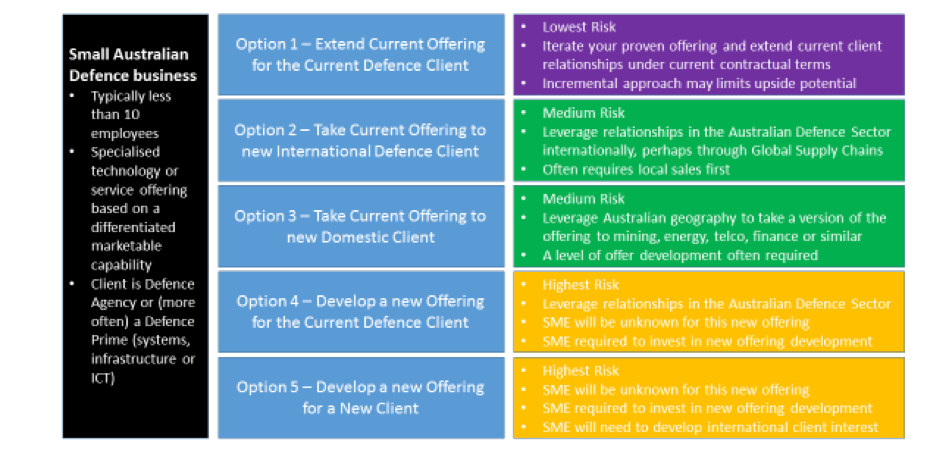KPMG partner Mike Kalms discovers what the most successful SMEs are doing to win defence contracts and thrive.
To continue reading the rest of this article, please log in.
Create free account to get unlimited news articles and more!
What do successful small Australian defence businesses look like?
The recently released Defence Industry Policy Statement states there are 3,000 defence businesses employing 25,000 Australians. In large handfuls, you can break this sector into one of five segments: the primes, infrastructure players, ICT providers, service companies and then the small-to-medium enterprise (SME) segment – perhaps the most diverse, productive, innovative and misunderstood component of Australia’s defence industry.
SME is somewhat of a misnomer in Australia’s defence sector. Frankly, the ‘M’ is absent here. It’s hard to think of more than three defence SME’s that have more than $50 million in turnover, or more than 250 employees, that isn’t aligned or partly owned by a global player. They exist, but really they prove the local rule that medium defence industry gets bought in Australia.
So looking at the small defence industry – possibly comprising over 60 per cent of the 3,000 businesses described by the federal government – what strategies are working?
I’ve seen these business’ as part of the Defence White Paper consultation process, I’ve seen them again during industry policy breakfasts sponsored by KPMG, and in some states I’ve seen them a third time developing that state or territories local defence business capture plans. I’d like to think this exposure provides a level of perspective.
In my experience, success in the defence sector is almost always underpinned by growth and diversification strategies. In other words, small businesses that succeed in defence are concurrently generating more cash, and importantly aren’t captured solely by Australian defence clients. They have diversified into international defence markets, or into adjacent markets locally. When you think about it, its common sense. Why? Because defence is a fickle client, prone to long annuity style contracts in the good times, but via long delays and painful boom-bust cycles. The diagram below depicts the strategic choices for small business in the defence sector, I’ll use it to explain my argument.

Figure 1 – Australian Small Defence Business has 5 strategic choices for growth
The five choices above reflect decisions about what the business produces and who it contracts with. In my view, the first and most obvious strategic choice is Option 1. Businesses are always pursuing Option 1. Each day when you interact with your customers you and your employees are exploring ways to do more, in effect deepen your current technology or service offering to benefit your client. When your business stops pursing Option 1, your business stops.
Options 2 and 3 are more a matter of choice, they require deliberate action to capture a level of investment and determination from the leadership to execute. Unlike Option 1, they need effort over and above the day-to-day. It’s for this reason many businesses don’t pursue them – the classic ‘in the business versus on the business’ time management dilemma. But in comparison to other choices available to the business owner, I argue these are the two you should be most focused on. They are the optimal risk bridge to growing your business from 10 people to 200 – and with that the opportunity to re-invest for further portfolio growth, or cash out as a rare attractive Australian medium-sized defence business.
The best news about Options 2 and 3 is that government is highly supportive of these strategies. There are several programs in place to enable you to join global supply chains for defence prime system integrators, programs to diversify your business portfolio locally, support to prepare business cases and associations to introduce you to partners providing the niche capabilities you need.
What about Options 4 and 5? Well, they are always interesting. When I encounter small defence businesses pursuing these last two options (sometimes inadvertently) it’s normally an indication of extravagance in leadership. The owner is either an extreme entrepreneur or not motivated by the finances of the company. Either way, bottom line performance is compromised as the business seeks a ‘home run’ technology or service offering neither it nor the market has to date experienced.
Almost all small business pursues Option 1, while good ones invest in and execute 2 and/or 3. If you believe you’re pursing 4 or 5, ask yourself: do I really have the surplus capital for this kind of bet?
With $195 billion of new capital investment by government in Defence, with defence industry featuring in the Prime Minister’s Innovation Agenda and with Christopher Pyne, the Defence Industry Minister, arguing strongly to spend Defence dollars in Australia, times have never been better for defence small business. Time to deploy a strategy that makes the most of this favourable environment.
Mike Kalms
Mike has more than 20 years’ experience in a variety of private and public sectors roles in Australia, Europe and Asia. He has worked in capability development, political, advisory, strategy, mergers and acquisitions and general profit and loss leadership roles. He has a strong general management and consulting resume in defence and defence adjacent sectors. His particular passion is working collaboratively with clients and stakeholders to deliver rapid performance improvement in the business and battlespace.

 Login
Login








